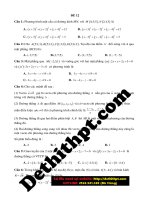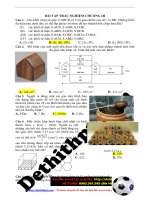Đề 39 image marked image marked
Bạn đang xem bản rút gọn của tài liệu. Xem và tải ngay bản đầy đủ của tài liệu tại đây (2.55 MB, 7 trang )
Exercise 39:
Read the following passage and mark the letter A, B, C or D to indicate the correct answer to each
of the questions.
Although he created the game of basketball at the YMCA in Springfield, Massachusetts, Dr. James
A. Naismith was a Canadian. Working as a physical education instructor at the International YMCA, now
Springfield College, Dr. Naismith noticed a lack of interest in exercise among students during the
wintertime. The New England winters were fierce, and the students balked at participating in outdoor
activities. Naismith determined that a fast-moving game that could be played indoors would fill a void
after the baseball and football seasons had ended.
Đăng ký file Word tại link sau
/>
First he attempted to adapt outdoor games such as soccer and rugby to indoor play, but he soon
found them unsuitable for confined areas. Finally, he determined that he would have to invent a game.
In December of 1891, Dr. Naismith hung two old peach baskets as either end of the gymnasium at
the school, and, using a soccer ball and nine players on each side, organized the first basketball game. The
early rules allowed three points for each basket and made running with the ball a violation. Every time a
goal was made, someone had to climb a ladder to retrieve the ball.
Nevertheless, the game became popular. In less than a year, basketball was being played in both the
United States and Canada. Five years later, a championship tournament was staged in New York City,
which was won by the Brooklyn Central YMCA.
Trang 1
The teams had already been reduced to seven players, and five became standard in the 1897 season.
When basketball was introduced as a demonstration sport in the 1904 Olympic Games in St. Louis, it
quickly spread throughout the world. In 1906, a metal hoop was used for the first time to replace the
basket, but the name basketball has remained.
QUESTION
Question 1: What does this passage mainly discuss?
A. The Olympic Games in St. Louis in 1904
B.The development of basketball
C. The YMCA athletic program
D. Dr. James Naismith
Question 2: When was the first demonstration game of basketball held during the Olympics?
A. 1891
B. 1892
C. 1897
D. 1904
Question 3: The phrase "balked at" in paragraph 1 could best replaced by _____.
A. resisted
B. enjoyed
C. excelled at
D. were exhausted by
Question 4: The word "fierce" in paragraph 1 is closest in meaning to ______.
A. long
B. boring
C. extreme
D. dark
Question 5: The word "them" in paragraph 2 refers to________.
A. indoors
B. seasons
C. games
D. areas
Question 6: Where in the passage does the author discuss the first basketball championship tournament?
A. paragraph 1
B. paragraph 2
C. paragraph 3
D. paragraph 4
Question 7: What does the author mean by the statement in paragraph 5: "When basketball was
introduced as a demonstration sport in the 1904 Olympic Games in St. Louis, it quickly spread throughout
the world"?
A. Basketball was not considered an Olympic sport at the St. Louis games.
B. Basketball became popular worldwide after its introduction at the Olympic Games in St. Louis.
C. Basketball players from many countries competed in the Olympic Games in St. Louis.
D. Basketball was one of the most popular sports at the Olympic Games in St. Louis.
Trang 2
Question 8: Why did Naismith decide to invent basketball?
A. He did not like soccer or rugby.
B. He was tired of baseball and football.
C. He wanted his students to exercise during the winter.
D. He could not convince his students to play indoors.
Question 9: The author mentions all of the following was typical of the early game of basketball
EXCEPT __________.
A. three points were scored for every basket
B. running with the ball was not a foul
C. nine players were on a team
D. the ball had to be retrieved from the basket after each score
Question 10: It can be inferred from the passage that the original baskets ________.
A. were not placed very high
B. had a metal rim
C. did not have a hole in the bottom
D. were hung on the same side
GIẢI CHI TIẾT
Question 1: What does this passage mainly discuss?
A. The Olympic Games in St. Louis in 1904 B. The development of basketball
C. The YMCA athletic program
D. Dr. James Naismith
Dịch nghĩa: Bài viết chủ yếu thảo luận cái gì?
A Cuộc thi Olympic ở St. Louis năm 1904
B. Sự phát triển của bóng rổ
C. Chương trình thể thao YMCA
D. Tiến sĩ James Naismith
Giải thích: Ta thấy từ đầu đến cuối bài viết nó quá trình phát triển của bóng rổ từ khi được sáng tạo ra
đến khi trở nên nổi tiếng trên toàn thế giới
Question 2: When was the first demonstration game of basketball held during the Olympics?
A. 1891
B. 1892
C. 1897
D. 1904
Dịch nghĩa: Khi nào trận bóng rổ biểu diễn đầu tiên đã được tổ chức ở Olympics?
A. 1891
B. 1892
C. 1897
D. 1904
Trang 3
Giải thích: "When basketball was introduced as a demonstration sport in the 1904 Olympic Games
in st. Louis.. "Ta thấy Olympics Ở St. Louis diễn ra vào năm 1904, vậy nên trận đấu bóng rổ đầu tiên ở
Olympics chỉ có thể vào chính năm đó - 1904.
Question 3: The phrase "balked at" in paragraph 1 could best replaced by _____.
A. resisted
B. enjoyed
C. excelled at D. were exhausted by
Dịch nghĩa: Cụm từ "balked at" ở đoạn 1 có thể được thay thế bởi ______.
A. trốn tránh
B. thưởng thức
C. có tài năng ở lĩnh vực...
D. đã mệt mỏi bởi...
Giải thích: Ta có (to) balk at sth = (to) resist sth: trốn tránh, chống lại cái gì
Question 4: The word "fierce" in paragraph 1 is closest in meaning to ______.
A. long
B. boring
C. extreme
D. dark
Dịch nghĩa: Từ "fierce" ở đoạn 1 gần nghĩa nhất với_________
A dài
B. nhàm chán
C. cực đoan
D. tối tăm
Giải thích: Ta có (to) be fierce = (to) be extreme: cực kì, dữ dội
Question 5: The word "them" in paragraph 2 refers to________.
A. indoors
B. seasons
C. games
D. areas
Dịch nghĩa: Từ "them" ở đoạn 2 nói đến _______.
A. trong nhà
B. mùa
C. môn thể thao
D. khu vực
Giải thích: Đọc cả câu ta thấy: "First he attempted to adapt outdoor games such as soccer and rugby to
indoor play, but he soon found them unsuitable for confined areas"-"Đẩu tiên anh ta cố gắng khớp hoạt
động ngoài trời như bóng đá hay bóng bầu dục để chơi trong nhà, nhưng nhanh chóng phát hiện ra
chúng không thích hợp cho những khu vực hạn chế."
Như vậy "them" ở đây là chỉ những môn thể thao ngoài trời.
Question 6: Where in the passage does the author discuss the first basketball championship tournament?
A. paragraph 1
B. paragraph 2
C. paragraph 3
D. paragraph 4
Dịch nghĩa: Ở đâu trong đoạn văn tác giả thảo luận giải đấu bóng rổ đầu tiên?
A. đoạn 1
B. đoạn 2
C. đoạn 3
D. đoạn 4
Trang 4
Giải thích: Ta thấy trong đoạn 4, tác giả viết: "ln less than a year,... Five years later, a championship
tournament was staged in New York City..."
Question 7: What does the author mean by the statement in paragraph 5: "When basketball was
introduced as a demonstration sport in the 1904 Olympic Games in St. Louis, it quickly spread throughout
the world"?
A. Basketball was not considered an Olympic sport at the St. Louis games.
B. Basketball became popular worldwide after its introduction at the Olympic Games in St. Louis.
C. Basketball players from many countries competed in the Olympic Games in St. Louis.
D. Basketball was one of the most popular sports at the Olympic Games in St. Louis.
Dịch nghĩa: Tác giả ngụ ý điều gì bằng khẳng định ở đoạn 5: "Khi bóng rổ được đưa vào như một môn
thể thao biểu diễn ở Olympics 1904 ở St. Louis, nó nhanh chóng lan truyền ra toàn thế giới"?
A. Bóng rổ không được coi như một môn thi đấu ở Olympic ở St Louis.
B. Bóng rổ trở nên thịnh hành trên toàn thế giới sau khi nó được đưa vào thế vận hội Olympic ở St.
Louis.
C. Vận động viên bóng rổ trên toàn thế giới đã thi đấu ở Olympic ở St. Louis.
D. bóng rổ là một trong số những môn thể thao thịnh hành nhất ở Olympic ở St. Louis.
Giải thích: Ta có (to) spread throughout the world = (to) be popular worldwide: trở nên nổi tiếng trên
toàn thế giới
Question 8: Why did Naismith decide to invent basketball?
A. He did not like soccer or rugby.
B. He was tired of baseball and football.
C. He wanted his students to exercise during the winter.
D. He could not convince his students to play indoors.
Dịch nghĩa: Tại sao Naismith lại quyết định sáng tạo ra bóng rổ?
A. Anh ta không thích bóng đá hay bóng bầu dục.
B. Anh ta mệt mỏi với bóng chày và bóng đá.
C. Anh ta muốn những học sinh của mình tập luyện trong mùa đông.
D. Anh ta đã không thể thuyết phục những học sinh của mình chơi trong nhà.
Giải thích: Ta thấy tác giả viết về Naismith:"Dr. Naismith noticed a lack of interest in exercise among
students during the wintertime... Naismith decided a fast moving game that could be played indoors
would fill a void after the baseball and football season has ended" - "Tiến sĩ Naismith nhận thấy một sự
Trang 5
thiếu hứng thú trong việc luyện tập trong mùa đông... Naismith quyết định rằng một trò chơi di chuyển
nhanh mà có thể chơi trong nhà có thể lấp đầy khoảng trống sau khi mùa bóng chày và bóng đá đã qua.."
Như vậy có thể thấy Naismith quyết định sáng tạo ra một môn thể thao mới do muốn học sinh của mình
luyện tập cả trong mùa đông.
Question 9: The author mentions all of the following was typical of the early game of basketball
EXCEPT __________.
A. three points were scored for every basket
B. running with the ball was not a foul
C. nine players were on a team
D. the ball had to be retrieved from the basket after each score
Dịch nghĩa: Tác giả đề cập đến tất cả những điều sau như đặc trưng của bóng rổ thời kì đầu ngoại trừ:
A. 3 điểm được ghi cho mỗi rổ
B. chạy cùng với bóng là không phạm luật
C. 9 người là 1 đội
D. quả bóng đã phải được lấy ra từ rổ sau mỗi điểm.
Giải thích: Ta thấy tác giả nói về luật của những trận bóng rổ đầu tiên ở đoạn 3: "The early rules allowed
three points for each basket and made running with the ball a violation"-"Những trận đấu đầu tiên cho
phép 3 điểm cho mỗi rổ và khiến chạy cùng với quả bóng là phạm luật". Như vậy ý B là không đúng
với ý tác giả.
Question 10: It can be inferred from the passage that the original baskets ________.
A. were not placed very high
B. had a metal rim
C. did not have a hole in the bottom
D. were hung on the same side
Dịch nghĩa: Có thể rút ra từ bài đọc là những chiếc rổ thời kì đầu ________.
A. đã không được đặt cao lắm
B. có một vòng kim loại
Trang 6
C. không có một cái lỗ ở dưới
D. đã được đặt ở cùng 1 phía
Giải thích: Ta thấy tác giả nói ở cuối đoạn 3: "Every time a goal was made, someone had to climb a
ladder to retrieve the ball" - "Mỗi lần một bàn thắng được ghi, một người nào đó phải trèo lên 1 cái
thang và lấy lại quả bóng."Vậy có thể hiểu cái rổ không có một cái lỗ để quả bóng tự rơi xuống.
DỊCH BÀI
Mặc dù đã phát minh ra bóng rổ ở YMCA ở Springfildm Massachusetts, Tiến sĩ James A. Naismith
là một người Canada. Là một giáo viên hướng dẫn giáo dục thể chất ở trường quốc tế YMCA, hiện nay là
Đại học Springfield, tiến sĩ Naismith nhận thấy một sự thiếu hứng thú trong việc luyện tập trong mùa
đông. Mùa đông ở New England rất dữ dội, và những học sinh thì trốn tránh việc tham gia vào những
hoạt động ngoài trời. Naismith quyết định rằng một trò chơi di chuyển nhanh mà có thể chơi trong nhà có
thể lấp đầy khoảng trống sau khi mùa bóng chày và bóng đá đã qua.
Ban đầu ông cố gắng
ngoài trời như bóng đá
để chơi trong nhà, nhưng
hiện ra chúng không
những khu vực hạn chế.
quyết định sẽ phải phát
thể thao mới.
đưa các hoạt động
hay bóng bầu dục
nhanh chóng phát
thích hợp cho
Cuối cùng, ông
minh ra một môn
Tháng 12 năm 1897,
treo 2 cái rổ đào cũ ở 2
dục ở trường, và, sử dụng
người cho mỗi đội, tổ
rổ đầu tiên. Những trận
phép 3 điểm cho mỗi rổ
với quả bóng là phạm
bàn thắng được ghi, một
trèo lên 1 cái thang và lấy lại quả bóng.
tiến sĩ Naismith
đầu phòng tập thể
1 quả bóng đá và 9
chức trận đấu bóng
đấu đầu tiên cho
và việc chạy cùng
luật. Mỗi lần một
người nào đó phải
Tuy nhiên, trò chơi dần trở nên phổ biến. Trong chưa đầy 1 năm, bóng rổ đã được chơi ở cả Mỹ và
Canada. 5 năm sau, một giải vô địch đã được diễn ra ở New York, với chiến thắng thuộc về đội Brooklyn
Central YMCA.
Đội chơi được giảm xuống còn 7 người, và 5 là chuẩn mực ở mùa thi đấu 1897. Khi bóng rổ được
giới thiệu là môn thể thao biểu diễn ở Olympic 1904 ở St. Louis, nó nhanh chóng lan ra toàn thế giới.
Năm 1906, một khung kim loại đã được dùng lần đầu tiên để thay thế cái rổ, nhưng cái tên bóng rổ vẫn
được giữ lại.
Trang 7









